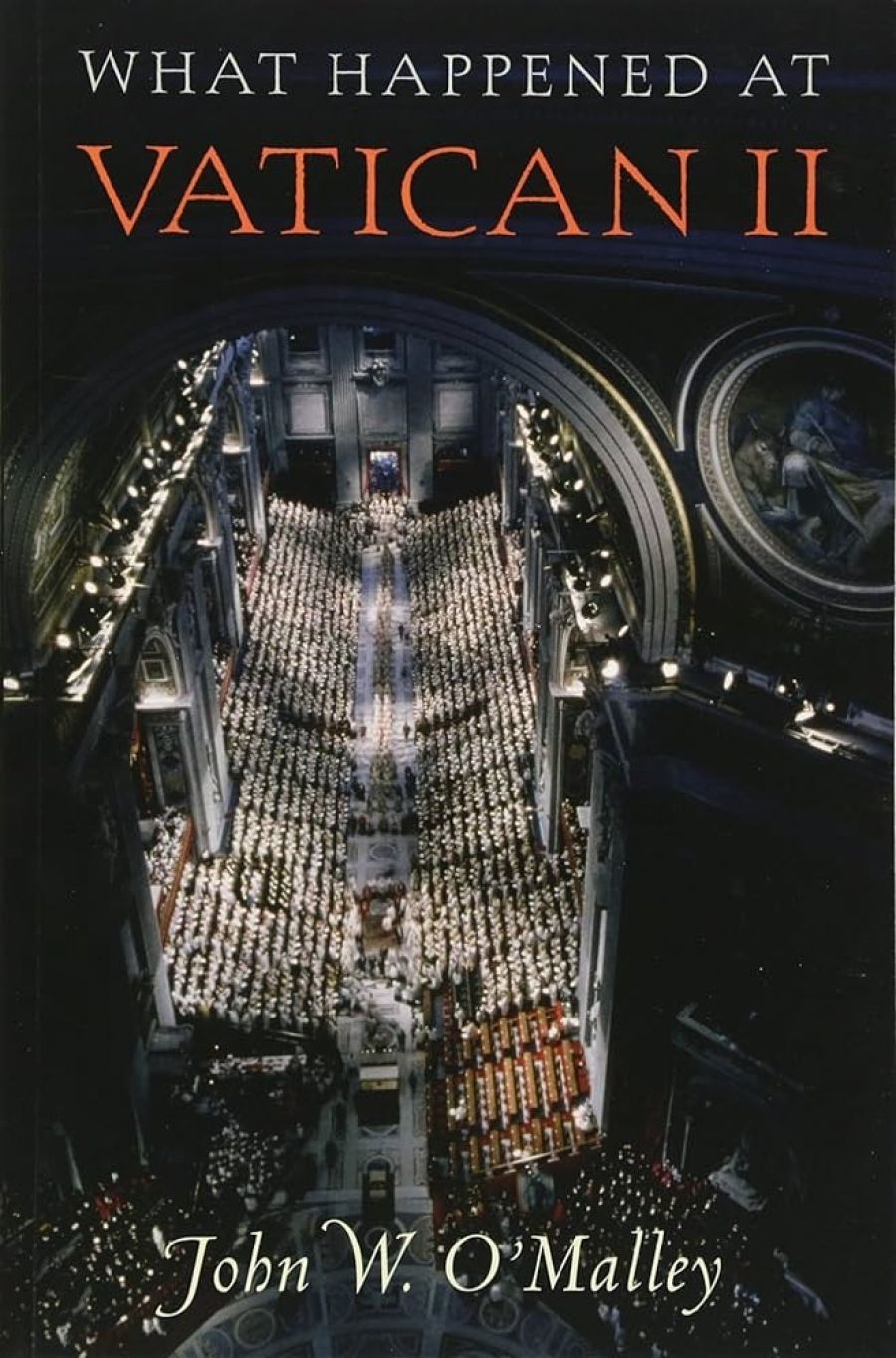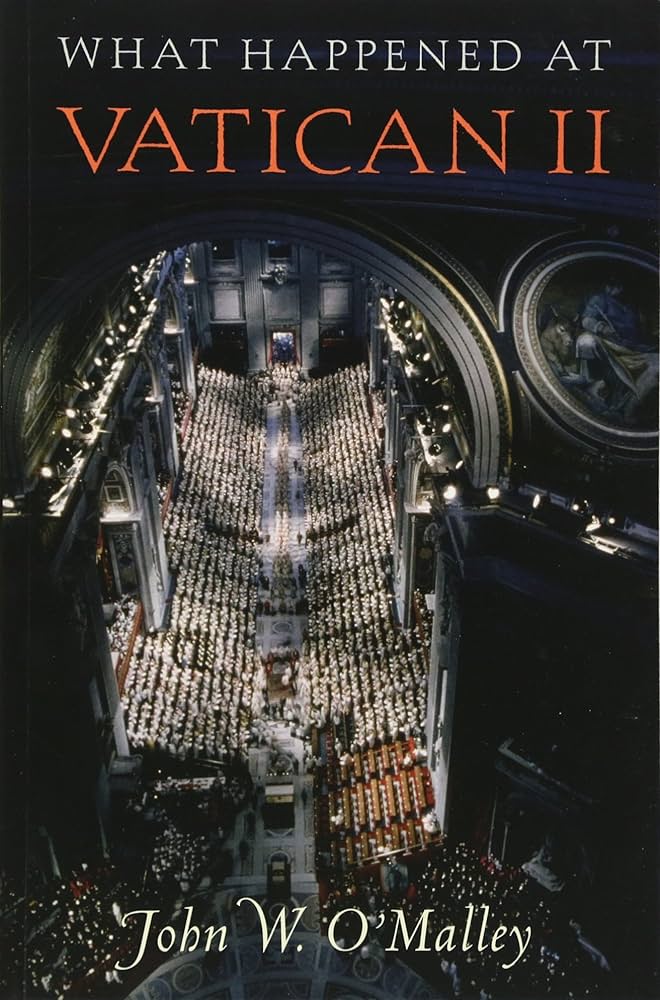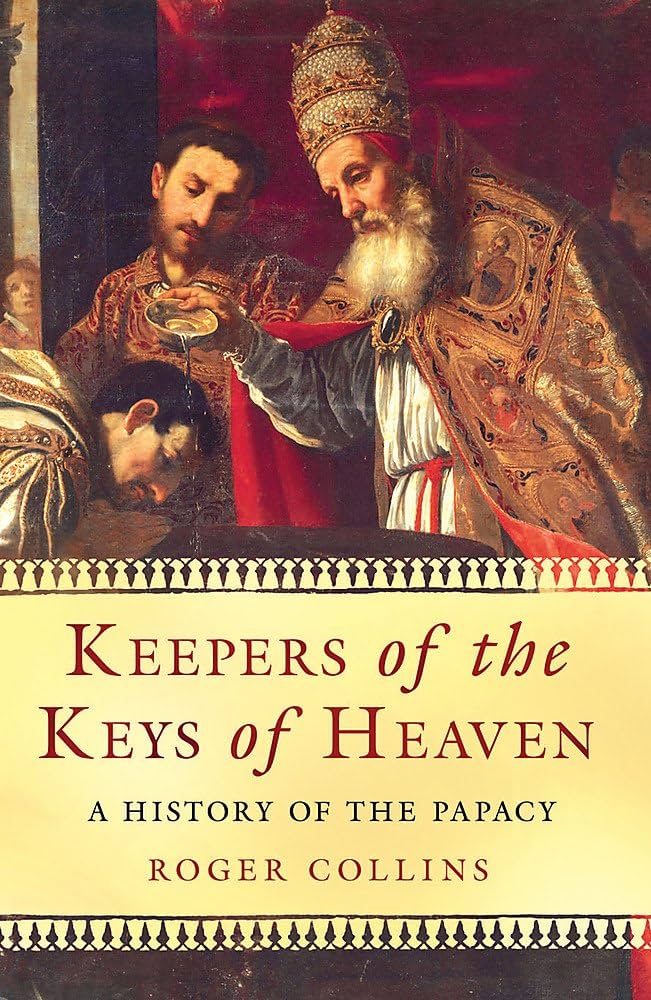
- Free Article: No
- Contents Category: History
- Review Article: Yes
- Article Title: The good, bad and indifferent
- Article Subtitle: Change and fallibility at the Vatican
- Online Only: No
- Custom Highlight Text:
Popes have long been wary of Church Councils, seeing them as possible rivals to their claim to absolute authority. When the Council of Constance met in 1414, there were three contending popes, each elected by a set of cardinals, and each with political support across Europe. At its end, two had been deposed, and the third, Gregory XII, having been recognised as pope, agreed to resign. A commission of Cardinals and others appointed by the Council then elected a new pope, Martin V, in 1417. Constance also decreed that the pope was to convene councils on a regular basis. Martin conformed for a time, but the practice soon fell away. Popes have preferred to govern alone, with the help of the Roman Curia.
- Book 1 Title: What Happened at Vatican II
- Book 1 Biblio: Harvard University Press, $49.95 hb, 380 pp
- Book 1 Cover Small (400 x 600):

- Book 1 Cover (800 x 1200):

- Book 2 Title: Keepers of the Keys of Heaven
- Book 2 Subtitle: A History of the Papacy
- Book 2 Biblio: Weidenfeld & Nicolson, $69.99 hb, 564 pp
- Book 2 Cover Small (400 x 600):

- Book 2 Cover (800 x 1200):

John XXIII did not have any particular agenda in mind when he announced the Council early in his pontificate, other than aggiornamento, the idea of bringing the Church up to date. This did not seem to strike much of a chord with the world’s bishops and others who were consulted. By and large, they asked for a tightening of the status quo and the condemnation of modern evils. Nor did the prospects for change improve when committees under the direction of the Curia drew up the preparatory documents in the following two years. The Council opened in October 1962, with some 2500 high-ranking clerics, all men, as official participants. (A few women were eventually admitted as lay auditors in the third session, in 1964.) Contrary to all expectations, the Council Fathers took control of the agenda from the beginning and subsequently threw out or greatly revised all the original documents on such matters as the liturgy, sources of belief, ecumenism, non-Christian religions, religious liberty, nuclear arms and other contemporary concerns.
None of this took place, however, without considerable struggle, antagonism, compromise and occasional high drama. In the end, each document secured a majority of around ninety per cent in the face of a tenacious and powerful minority. The strength that carried the majority came from a relatively small number of ‘Transalpine’ German, French and Belgian Cardinals, also the colourful Maximos IV Saigh, Melkite patriarch of Antioch.
The strength of this leading group was not simply their strong case for modernisation in a Church long marked by authoritarianism and fear of the modern world. No less significantly, they had a good command of the biblical sources and the history of Christian thought, and were aware of the opportunities that a return to sources offered for a renewal of theology and Christian life. They also had excellent advisers on hand, including the renowned theologian Karl Rahner, the young Joseph Ratzinger and John Courtney Murray, the leading authority on religious freedom. In this way, the proponents of change could argue that they were the true conservatives in the Church, rather than the minority leaders who wanted little more than a reaffirmation of the teachings of Trent and Vatican I and subsequent papal teaching.
O’Malley, a distinguished historian at Georgetown University, tells the story with judgement and narrative skill. In tracing the course of the various disputes, he prefers to speak of the two parties as ‘the majority’ and ‘the minority’, on the grounds that these terms are directly verifiable and less prejudicial than alternatives. They are to be preferred, he suggests, to pitting liberals and progressives on one side against conservatives and reactionaries on the other. Nonetheless, he marks out the respective positions at each stage as either progressive or reactionary, so the terms ‘majority’ and ‘minority’ are both verifiable and perfectly clear. The only striking variation to this pattern came when Cardinal Ottaviani, Head of the Holy Office and leading figure in the minority party, took a strong stand against war in the debate on the promotion of peace. In this, Ottaviani was being faithful in fact to the teaching of John XXIII in his last encyclical ‘Pacem in Terris’ and Paul VI’s plea for peace at the United Nations in 1965, just a few days before his own speech at the Council.
John XXIII died in June 1963, six months after the first session. He had intervened at just one point to revise the regulations to provide for a rule of closure on debate. Then, over the winter, he approved the establishment of a coordinating commission to expedite business. With Paul VI, intervention on more substantial matters became a regular occurrence, initiated often by the minority party, sometimes by the majority party and more commonly by the pope himself. This learned and moderately liberal man would go over council documents with a ‘red pencil’, editing them as he went, something unprecedented in the history of Councils. At critical points, he simply took controversial issues off the agenda, reserving them for papal decision: in particular, priestly celibacy, birth control, reform of the Curia and the implementation of collegiality beyond the Council.
Just as the final session began, Paul VI released a document establishing the Synod of Bishops as an advisory body subject ‘immediately and directly to the power’ of the pope. Collegiality did not rate a mention. With this pre-emptive stroke, as O’Malley says, the pope cut collegiality off from a grounding in the institutional reality of the Church. Two years later, he released an encyclical on priestly celibacy that reaffirmed the discipline while turning a blind eye to problems in the priesthood, scandals past and yet to come. A year later, he issued the encyclical Humanae Vitae reaffirming the teaching of his recent predecessors concerning contraception.
Much has changed in the fifty years since John XXIII announced that he would call a Council. O’Malley records the achievements and failures of Vatican II and explores its underlying character and style. He does not, however, attempt to judge its significance in the longer term other than to suggest that that is currently far from clear. But interested parties could not hope to find a more illuminating study of what happened at the time.
Roger Collins’s amazing single-volume history of the papacy covers some of the same ground in its last two chapters, especially in regard to popes around the mid twentieth century. From Collins, indeed, one learns that John XXIII originally wanted the Council to be held at the Basilica of St Paul Without the Walls, on the Via Ostiense, perhaps to have a missionary focus and to be called The Council of the Ostian Way. Moreover, the book begins with the story of the unlikely discovery of the bones of Peter the Apostle deep beneath St Peter’s in 1942, the botched archaelogical analysis and the long-held secret until Paul VI announced in 1968 – with no mention of the previous uncertainty and changes of opinion – that the bones of Peter had been discovered. Collins refers also to the election of antipopes by post-Council ultra-traditionalists, but none is listed in the helpful list of popes and antipopes provided at the end.
Papal concern about Councils went back far beyond the Middle Ages. From the fourth century, at least, popes held the firm view that Councils should do no more than confirm prior papal decisions. Pope Leo the Great (440–61) summed this up in declaring that, among bishops, ‘nothing was ever to be at odds with the leadership of the see of Peter’. This was not a view that ever gained support in the East or in the then flourishing Church in North Africa.
Keepers of the Keys of Heaven consists of twenty-one chapters, each of around twenty-five pages and covering in chronological order around one hundred years of the papacy (but rarely coinciding with any given century). It is an impressive work, compendious, scholarly, accessible, comprehensive within the limits of a single volume, and full of measured judgement. One might wish to read it from cover to cover. Otherwise it is an excellent short reference book for any period of this long-lived institution. Collins, a well-known medieval historian, is at home across the whole field.
It is probable, but not certain, that the apostle Peter visited Rome. The role of bishop emerged only gradually in the early Church, and it is likely that, up to around 150 ce, bishops of Rome had been leaders who were put down as bishops on a retrospective list. Had an early council been held in Rome, women may have had a prominent role, for there is evidence that, as deacons and possibly priests, they were leaders and teachers in a number of local churches in the city. Change came with the development of a hierarchical clerical élite in the course of the second century.
Change on a larger scale arrived in the fourth century when the Emperor Constantine embraced Christianity (in a sense) and the Church entered a long, complicated relationship with political power. Collins follows this story of reliance and harassment across the centuries, through the Middle Ages and the Crusades, the rise of nation states, the emergence of the modern world, the loss of the Papal States in 1870, to the 1929 Lateran Treaty with Italy, which settled the status of the Vatican as a small independent state, and beyond.
Again, Collins covers the never-ending story of doctrinal dispute within Christianity, the early heresies and schisms, the separation of East and West, the great turning point of the Reformation, and the anti-modernist crisis that ran on close to the time of Vatican II. In short, he tells the story of all the popes (and the recognised antipopes): the great and the good, the indifferent and the bad, down to Pope Benedict XVI.


Comments powered by CComment